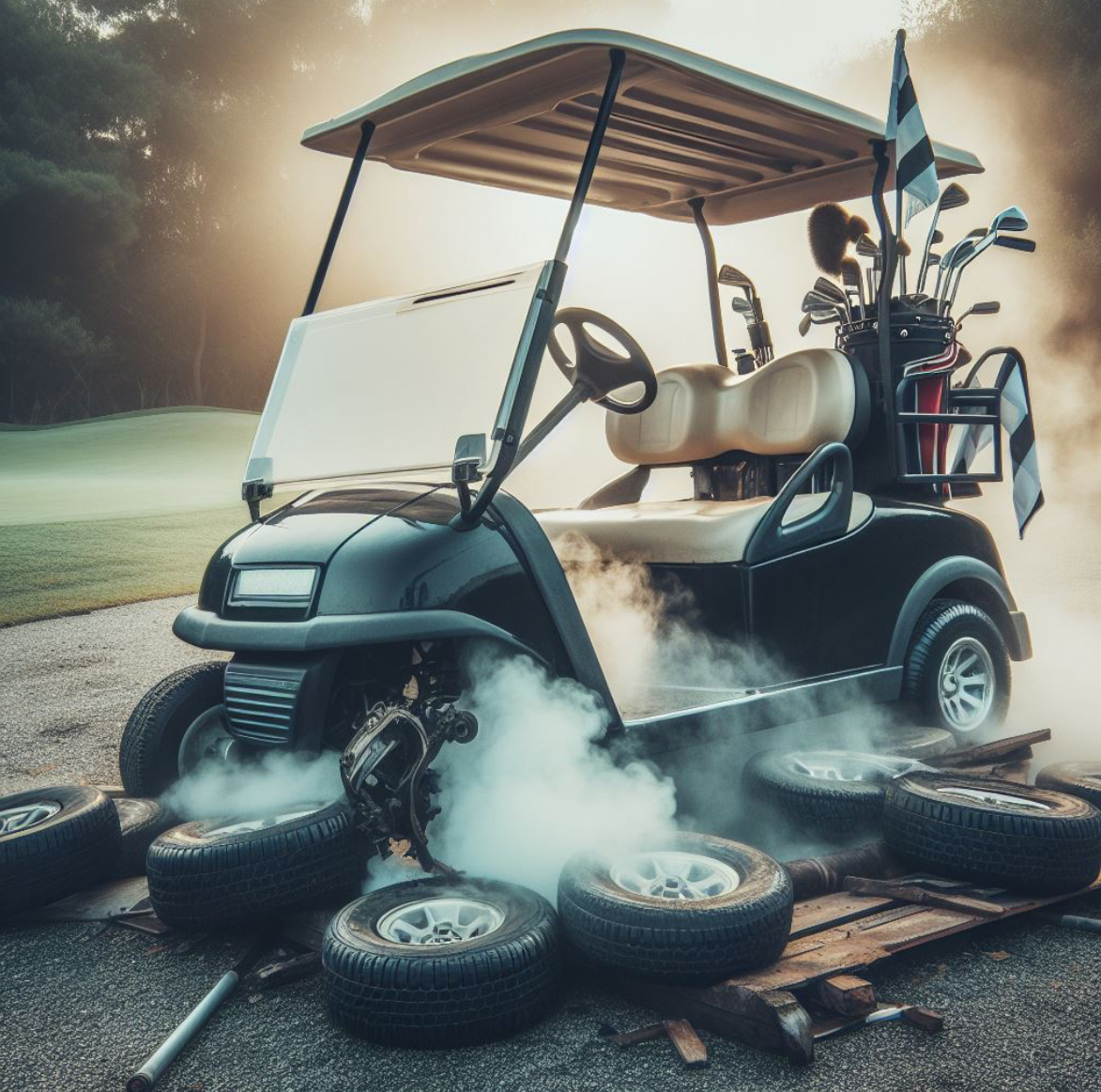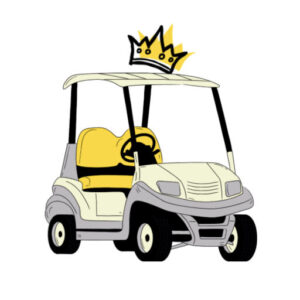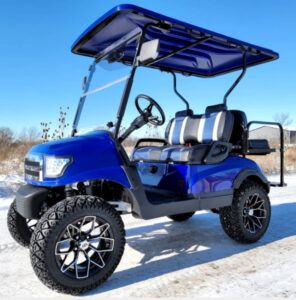
Today, we’ll explore some of the most common golf cart problems owners encounter and provide practical solutions to keep these trusty companions running smoothly. From battery woes to electrical glitches, motor malfunctions to tire troubles, we’ll cover it all. By understanding these issues and implementing proactive maintenance measures, you can ensure your golf cart remains reliable and enjoyable for years to come.
In reality, golf carts have become indispensable vehicles in various settings, ranging from leisurely rounds on the golf course to practical transportation in residential communities and commercial establishments. These versatile vehicles offer convenience, efficiency, and eco-friendliness, but like any mechanical device, they are prone to issues that can hinder their performance.
Therefore, whether you’re a seasoned golfer, a community resident, or a business owner, this post is designed to be your go-to resource for troubleshooting golf cart problems. So, let’s dive in and address these common issues head-on, empowering you to tackle any challenges that may arise with confidence and ease.
Common Golf Cart Battery Problems
Golf carts rely heavily on their batteries to provide the power necessary for smooth operation. However, battery problems are among the most common issues that owners encounter. Understanding these issues and implementing proper maintenance techniques can help extend the life of your batteries and keep your golf cart running efficiently.
Common Battery Problems:
Low Charge: One of the most obvious signs of a battery issue is a low charge. If your golf cart struggles to maintain power or requires frequent recharging, it could indicate a problem with the batteries. Low charge can be caused by a variety of factors, including excessive use, age, and improper charging habits.
Corrosion: Corrosion on battery terminals is another common problem that can affect performance. Over time, buildup of corrosion can interfere with the flow of electricity and prevent proper charging. Regular cleaning and maintenance of battery terminals can help prevent corrosion and ensure optimal performance.
Dead Cells: Dead cells occur when one or more cells within the battery fail, causing a decrease in overall battery capacity. This can lead to decreased run time and performance issues. Dead cells are often caused by overcharging, excessive heat, or old age.
Battery Maintenance Tips:
Proper Charging: Follow manufacturer guidelines for charging your golf cart batteries. Overcharging or undercharging can lead to decreased battery life and performance. Use a quality charger designed for your specific battery type and avoid leaving the batteries on the charger for extended periods.
Regular Inspections: Perform regular inspections of your batteries to check for signs of damage, corrosion, or leaks. Look for bulging or swollen areas, which may indicate internal damage. Clean battery terminals regularly to prevent corrosion buildup.
Water Levels: If you have flooded lead-acid batteries, check the water levels regularly and top up as needed with distilled water. Proper water levels are essential for optimal battery performance and longevity.
Solutions:
Cleaning Terminals: If you notice corrosion on battery terminals, clean them thoroughly using a mixture of baking soda and water. Disconnect the batteries before cleaning and use a wire brush to remove corrosion buildup.
Water Level Check: If your batteries require water, top them up with distilled water to the recommended level. Be careful not to overfill, as this can cause electrolyte spillage.
Battery Replacement: If your batteries are old or damaged beyond repair, it may be time to invest in replacements. Consider upgrading to high-quality batteries with a longer lifespan and better performance.
Notably, by implementing these maintenance tips and addressing battery issues promptly, you can prolong the life of your golf cart batteries and ensure reliable performance on the course or around your community.
Electrical System Failures
The electrical system of a golf cart is a complex network of components that work together to power lights, motors, and other essential functions. When the electrical system fails, it can lead to a range of issues that affect the performance and safety of the vehicle. Understanding common electrical system failures and knowing how to troubleshoot them is essential for maintaining your golf cart.
Common Electrical System Failures:
Blown Fuses: Blown fuses are a common electrical problem in golf carts and can occur due to overloaded circuits or short circuits. When a fuse blows, it interrupts the flow of electricity to the affected component, resulting in loss of function.
Faulty Wiring: Wiring issues such as frayed or corroded wires can cause electrical problems in golf carts. Over time, exposure to moisture, heat, and vibration can damage wiring, leading to intermittent or complete loss of power.
Malfunctioning Lights: Lights are an essential safety feature on golf carts, but they can be prone to failure due to issues such as burned-out bulbs, faulty switches, or corroded connections. Malfunctioning lights can reduce visibility and increase the risk of accidents, especially when driving at night.
Troubleshooting Steps:
Testing Fuses: If you suspect a blown fuse is causing an electrical issue, use a multimeter to test the continuity of the fuse. Replace any blown fuses with ones of the same amperage rating.
Checking Connections: Inspect all electrical connections for signs of corrosion, looseness, or damage. Tighten loose connections and clean corroded terminals using a wire brush and electrical contact cleaner.
Testing Components: Use a multimeter to test the continuity and voltage of electrical components such as switches, lights, and motors. Replace any faulty components as needed.
Solutions:
Fuse Replacement: If a blown fuse is the culprit, replace it with a new one of the same amperage rating. Be sure to address any underlying issues, such as overloading circuits or short circuits, to prevent future fuse failures.
Wiring Repair: If you identify damaged wiring, repair or replace the affected wires to restore proper electrical function. Use high-quality replacement wires and connectors to ensure a reliable repair.
Component Replacement: If electrical components such as switches or lights are malfunctioning, replace them with new ones. Choose components that are compatible with your golf cart’s make and model for optimal performance.
So, by following these troubleshooting steps and implementing appropriate solutions, you can address common electrical system failures in your golf cart and ensure reliable operation on the course or around your community. Regular maintenance and periodic inspections are key to preventing electrical problems and maintaining the safety and performance of your vehicle.
Motor And Powertrain Troubles
The motor and powertrain are the heart of any golf cart, providing the necessary propulsion for movement. When issues arise with these critical components, it can significantly impact the performance and reliability of the vehicle. Understanding common motor and powertrain troubles and knowing how to troubleshoot them is essential for keeping your golf cart running smoothly.
Common Motor and Powertrain Troubles:
Overheating: Overheating is a common issue in electric golf cart motors, especially during extended use or in hot weather conditions. Excessive heat can lead to motor damage and decreased performance.
Strange Noises: Unusual noises such as grinding, squealing, or clicking may indicate problems with the motor or powertrain components. These noises can be caused by issues such as worn bearings, loose belts, or misaligned components.
Loss of Power: A sudden loss of power or acceleration can be a sign of motor or powertrain issues. This can occur due to factors such as worn brushes, damaged wiring, or malfunctioning controllers.
Troubleshooting Techniques:
Inspect for Leaks: Check for any signs of fluid leaks around the motor and powertrain components, as leaks can indicate issues such as worn seals or damaged gaskets.
Listen for Abnormal Sounds: Pay attention to any unusual sounds coming from the motor or powertrain while driving. Identify the source of the noise and inspect the affected components for damage or wear.
Monitor Temperature: Keep an eye on the temperature gauge or warning lights to monitor the motor’s temperature. If the motor starts to overheat, stop driving immediately and allow it to cool down before continuing.
Solutions:
Lubrication: Ensure that all moving parts of the motor and powertrain are properly lubricated to reduce friction and heat buildup. Use high-quality lubricants recommended by the manufacturer for optimal performance.
Component Replacement: If you identify worn or damaged components such as bearings, belts, or brushes, replace them with new ones to restore proper function. Choose replacement parts that are compatible with your golf cart’s make and model.
Professional Maintenance: Schedule regular maintenance inspections with a qualified technician to check the motor and powertrain for any issues and perform necessary repairs or adjustments. Professional maintenance can help prevent problems and prolong the life of your golf cart’s motor and powertrain.
Therefore, by following these troubleshooting techniques and implementing appropriate solutions, you can address common motor and powertrain troubles in your golf cart and ensure reliable performance on the course or around your community. Regular maintenance and proactive monitoring are key to keeping your vehicle running smoothly for years to come.

Golf Cart Tire And Suspension Problems
Tires and suspension play an important role in the performance and safety of your golf cart. Issues with tires or suspension components can affect handling, comfort, and even safety while driving. Understanding common tire and suspension problems and knowing how to address them can help keep your golf cart in top condition.
Common Tire and Suspension Problems:
Flat Tires: Flat tires are a common issue that can occur due to punctures, leaks, or improper inflation. Driving with a flat tire can cause further damage to the wheel and suspension components.
Uneven Wear: Uneven tire wear is often caused by misalignment, improper inflation, or worn suspension components. Uneven wear can lead to decreased traction, poor handling, and premature tire failure.
Suspension Squeaks: Squeaking or creaking noises coming from the suspension can indicate worn bushings, springs, or other suspension components. These noises can affect ride comfort and indicate potential safety issues.
Troubleshooting Tips:
Inspect Tires Regularly: Check the condition and pressure of your golf cart tires regularly. Look for signs of damage, such as cuts, bulges, or uneven wear. Ensure that tires are properly inflated to the manufacturer’s recommended pressure.
Check Alignment: Misaligned wheels can cause uneven tire wear and affect handling. Have your golf cart’s alignment checked periodically by a qualified technician and adjust as needed to ensure even tire wear and optimal handling.
Listen for Noises: Pay attention to any unusual noises coming from the suspension while driving, such as squeaks or creaks. Identify the source of the noise and inspect the affected suspension components for wear or damage.
Solutions:
Tire Repair or Replacement: If you have a flat tire, repair it using a patch kit or replace it with a new tire if the damage is extensive. Ensure that the replacement tire matches the size and type of the original tire.
Alignment Adjustment: If your golf cart’s wheels are misaligned, have them adjusted by a qualified technician to ensure even tire wear and optimal handling. Proper alignment can also help prevent suspension wear and improve ride comfort.
Suspension Maintenance: Inspect suspension components regularly for signs of wear or damage, such as worn bushings, springs, or shocks. Replace worn or damaged components as needed to restore proper suspension function and ride quality.
In general, by following these troubleshooting tips and implementing appropriate solutions, you can address common tire and suspension problems in your golf cart and ensure a smooth and safe driving experience. Regular maintenance and periodic inspections are key to preventing issues and prolonging the life of your golf cart’s tires and suspension components.
Steering And Brake Concerns
The steering and brake systems are vital components of any golf cart, ensuring safe and precise control while driving. Issues with steering or brakes can compromise the safety and performance of your vehicle, making it essential to address these concerns promptly. In this section, we’ll discuss common steering and brake problems encountered in golf carts and provide solutions to help you maintain optimal control and safety.
Common Steering and Brake Concerns:
Difficulty Turning: Difficulty turning the steering wheel can indicate problems with the steering system, such as worn components, lack of lubrication, or misalignment. Steering issues can make it challenging to navigate corners and obstacles safely.
Brake Squealing: Squealing or squeaking noises when applying the brakes can be a sign of worn brake pads or shoes. Brake squealing can indicate reduced braking efficiency and increase stopping distances, posing a safety hazard.
Loss of Stopping Power: A sudden loss of stopping power or increased pedal travel when applying the brakes can indicate issues with the brake system, such as air in the brake lines, worn brake components, or brake fluid leaks. Loss of stopping power can compromise safety and increase the risk of accidents.
Troubleshooting Steps:
Inspect Steering Components: Check the steering components, including the steering column, tie rods, and steering rack, for signs of wear, damage, or misalignment. Lubricate moving parts as needed and tighten any loose connections.
Check Brake Pads/Shoes: Inspect the brake pads or shoes for signs of wear, such as thinning or uneven wear patterns. Replace worn brake pads or shoes with new ones to restore proper braking performance.
Inspect Brake Fluid: Check the brake fluid level and condition in the master cylinder reservoir. Top up the brake fluid if necessary and inspect the brake lines and calipers for signs of leaks or damage.
Solutions:
Steering Adjustment: If you experience difficulty turning the steering wheel, have the steering system inspected and adjusted by a qualified technician. Proper alignment and adjustment of steering components can restore smooth steering operation.
Brake Pad/Shoe Replacement: If brake pads or shoes are worn beyond their service limit, replace them with new ones to restore proper braking performance. Use high-quality replacement pads or shoes recommended by the manufacturer for optimal safety and performance.
Brake System Inspection: If you experience a loss of stopping power or other brake-related issues, have the brake system inspected by a qualified technician. Address any leaks, worn components, or air in the brake lines to restore proper braking function and safety.
Specifically, by following these troubleshooting steps and implementing appropriate solutions, you can address common steering and brake concerns in your golf cart and ensure safe and reliable operation on the course or around your community. Regular maintenance and periodic inspections are essential for identifying and resolving issues before they escalate into safety hazards.
Conclusion
Maintaining a golf cart in optimal condition is essential for ensuring safe and reliable operation on the course or around your community. Additionally, by addressing common problems promptly and implementing proactive maintenance practices, you can prolong the life of your golf cart and enjoy worry-free driving experiences.
Throughout this post, we’ve explored some of the most common issues golf cart owners encounter, from battery woes to steering concerns, and provided practical solutions to help you troubleshoot and resolve these problems. By understanding the underlying causes of these issues and knowing how to address them effectively, you can keep your golf cart running smoothly for years to come.
Remember, regular maintenance is key to preventing problems and prolonging the life of your golf cart. Schedule periodic inspections, checkups, and tune-ups with a qualified technician to identify and address any issues before they escalate into larger problems. Additionally, follow manufacturer guidelines for proper maintenance and operation of your golf cart to ensure optimal performance and safety.
We hope this guide has been helpful in empowering you to tackle common golf cart problems with confidence and ease. By staying proactive and vigilant, you can enjoy many more rounds of smooth, trouble-free driving in your trusty golf cart.
 Happy Carting!
Happy Carting!
Shop Golf Carts

